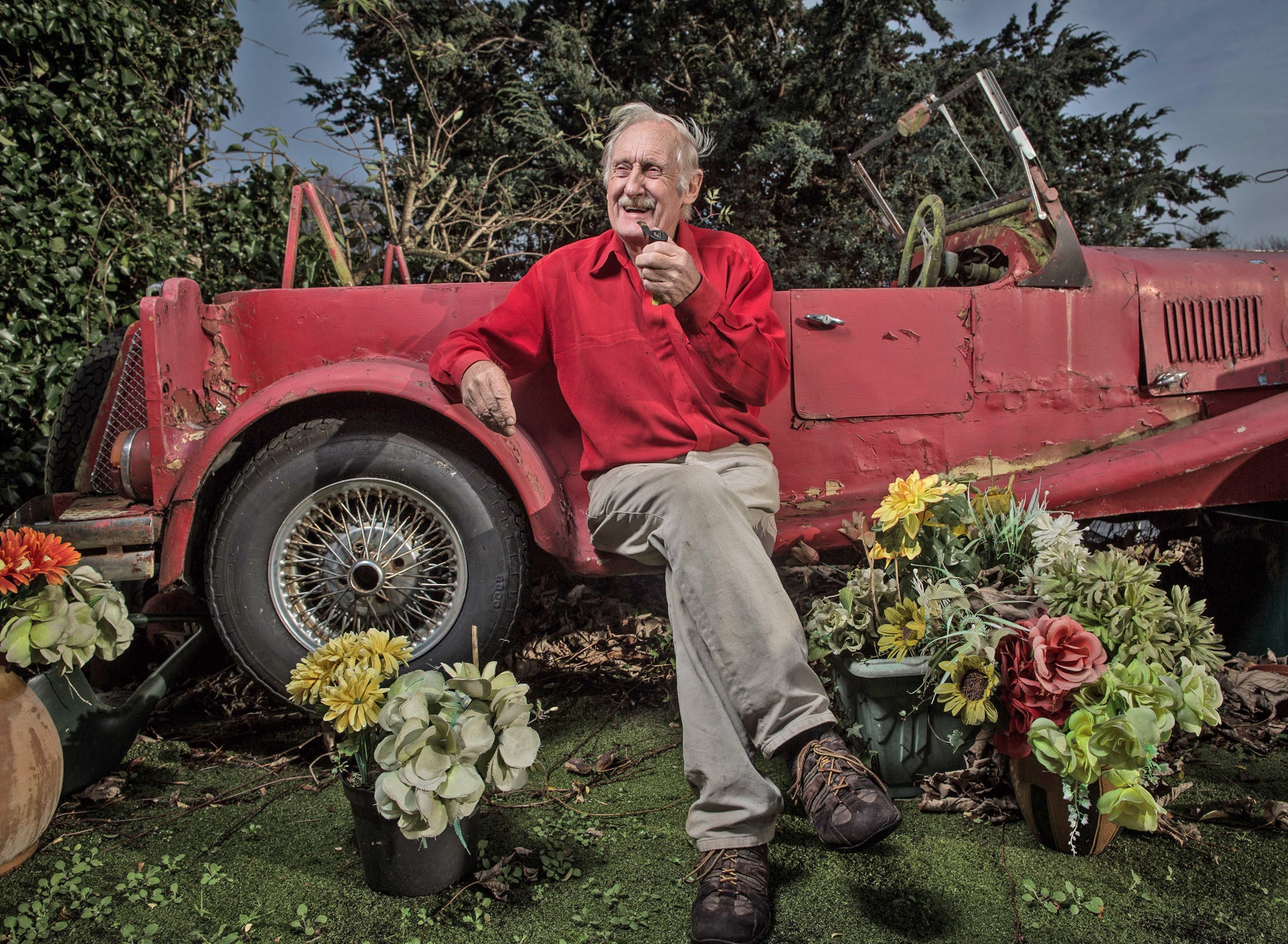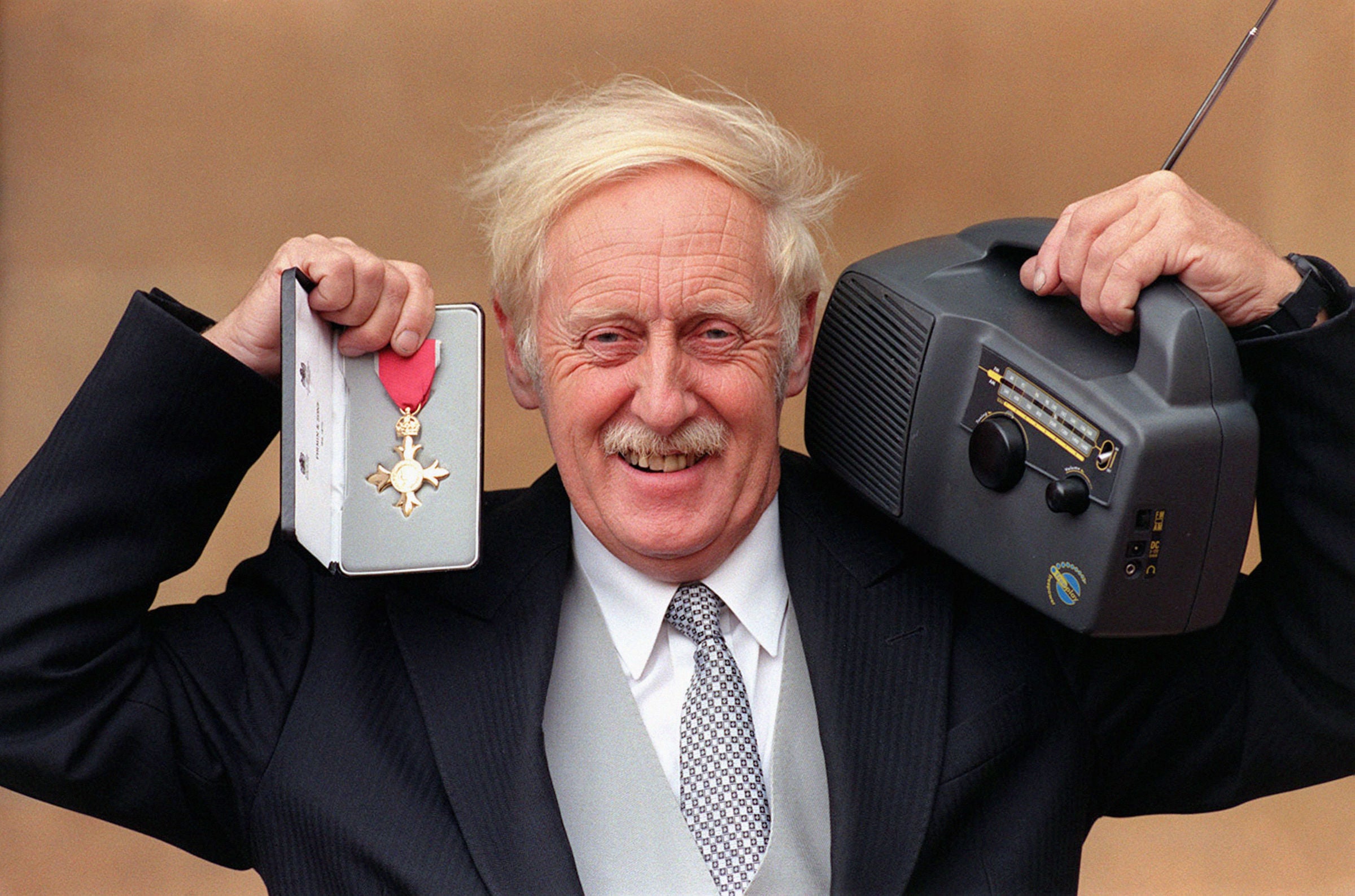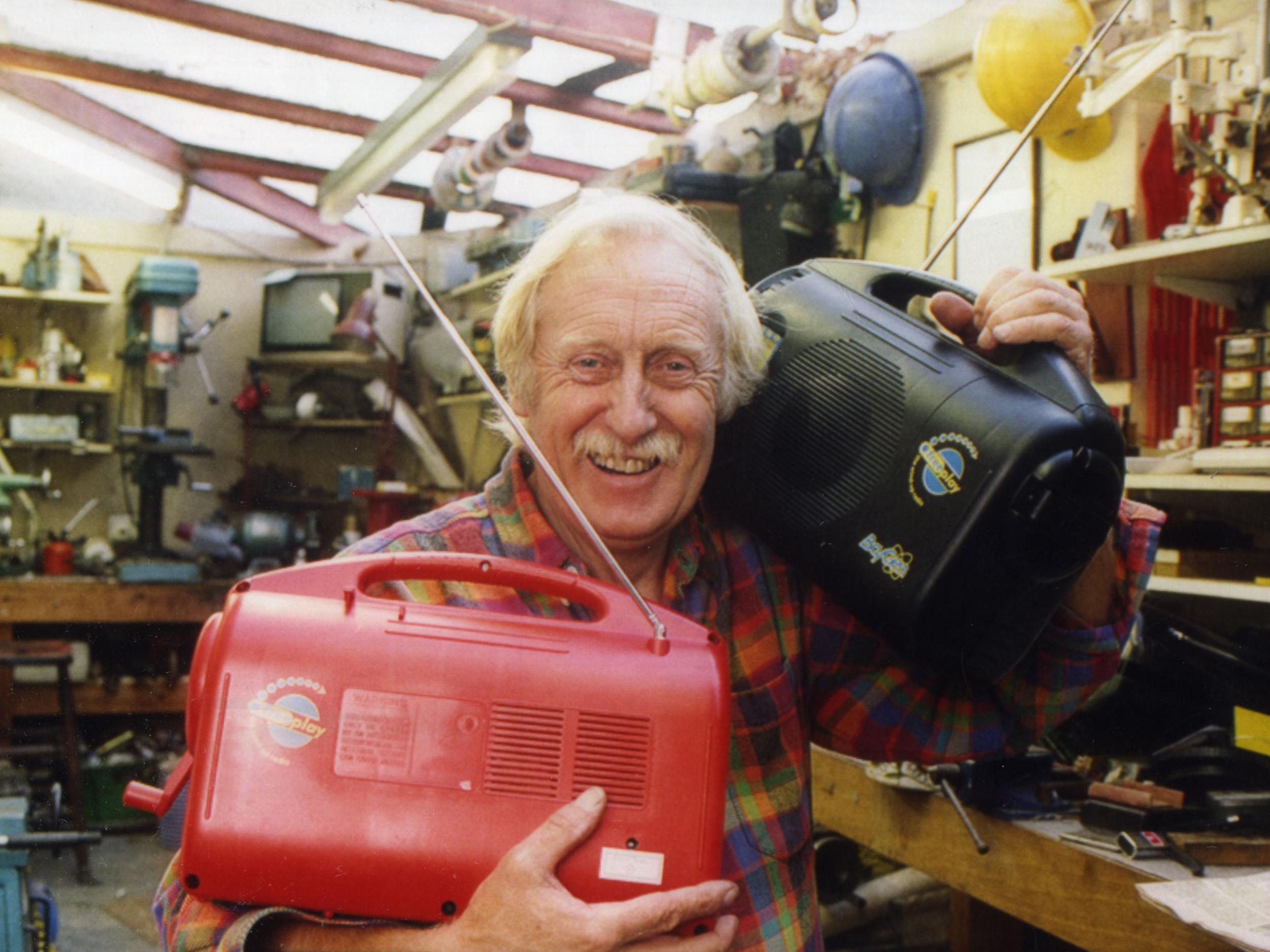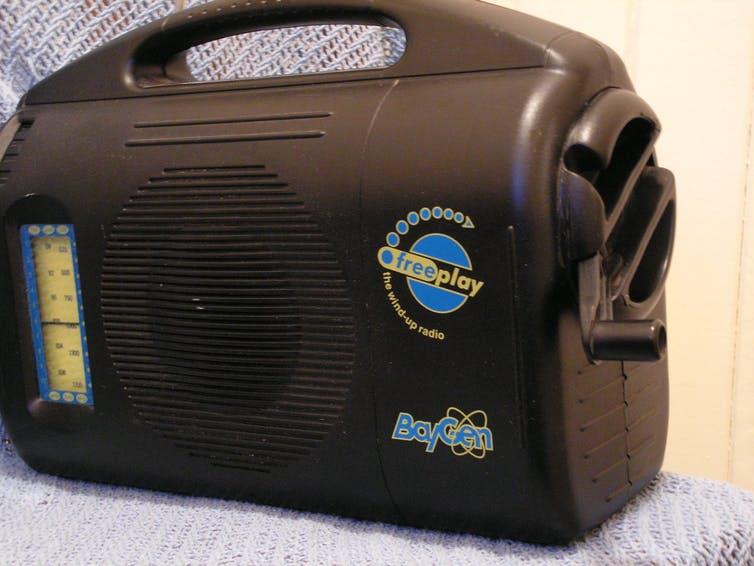Trevor Baylis: Inventor whose wind-up radio helped remote parts of Africa tune in to education
Known for his charm and showmanship, Baylis started off as a diver performing stunts to sell swimming pools and came close to representing Britain as swimmer in the 1956 Olympics

One evening in the autumn of 1991, Trevor Baylis sat at home, watching a documentary about the spread of Aids in Africa. Upon learning that one of the greatest obstacles to halting the epidemic was extending health education to poor and remote communities in African countries, he set about developing a radio that would require neither access to an electrical grid nor even to batteries, which were expensive. His invention, a radio that could be powered by muscle alone, changed the lives of millions, making it easier than ever before to catch airwaves and all the treasures they carry.
That was the story as Baylis told it, and as most people know it today. And it was largely true, except for two important facts. First, he did not develop the wind-up radio all on his own. Second, the version he did develop was not much cop at all.
The idea was a good one, but the prototype Baylis made was mediocre. In 2002 a certain David Broughton, whose contribution to this invention is still little known, was recognised as joint inventor by the UK’s Patent Office, after having fought for that status. Baylis and his business partners, to whom he had claimed he was the sole proprietor of the intellectual property on the wind-up radio, had settled a dispute with Broughton two months earlier, for a six-figure sum, after Broughton produced evidence indicating his involvement.
The settlement and patent office decision never made headline news and Baylis remained, in the public eye, the sole mind behind one of the most important inventions of the late 20th century.
Baylis, who died aged 80, with no immediate survivors, was a master craftsman of practical solutions to everyday problems, conceiving hundreds of inventions and swiftly realising their prototypes. But he was also a master craftsman of his own public image, constantly promoting himself and sometimes failing to recognise the contributions of others. His enthusiasts viewed him as a modern-day Thomas Edison, emerging from a difficult childhood to become one of the greatest inventors of his time; his detractors said his greatest invention was none other than himself.
Trevor Graham Baylis was born in northwest London in 1937, a day after George VI’s coronation, the only child of Cecil Archibald Walter Baylis and of his wife Gladys Jane Baylis, née Brown. Around that time Frank Whittle, who would later become Baylis’s hero, tested his first jet engine.
As a child during the Second World War, Baylis collected shrapnel, treated the Blitz as a free fireworks display, and slept in an Anderson shelter that smelled of damp earth, unwashed bodies and cat pee.
At school he was thought to be, in his own words, “dimmer than the blackout”, struggling as he did with mathematics and with English. Transforming Meccano construction kits into boats, cars, bridges and cranes, he felt, for the first time, that he might not be so hopeless after all. He had found something he loved, and was good at.

Taking his first strokes in the rancid waters of Grand Union Canal, he soon realised he might also become good at swimming, and dedicated himself to that sport.
Those early years he would later call “golden and untroubled”, because they would be followed by an experience that profoundly traumatised him.
One afternoon in September of 1943, his Sunday school teacher asked him to stay behind after class, and raped him. The boy did not tell his parents, as he thought they would not believe him, but he did eventually tell the story, in all of its horrid detail, in his 1999 autobiography, Clock This. For two months the molestations carried on, then abruptly they stopped. “He must have found another victim,” Baylis surmised.
“That lonely, sickening experience stole something from me for all time,” he wrote of those few weeks. “Not wanting to show off how much I’d been hurt, I shielded myself in cocky isolation.” It also drove him away from organised religion for good.
Baylis failed his 11-plus exam and went to Dormer’s Wells secondary school in Southall, west London, where the accent was on practical skills. He became a subscriber to The Model Engineer, reading every word of every issue, and spent hours learning from his father in the family shed, which to Baylis was “like a shrine”.
He became increasingly serious about his swimming, too, sometimes training as many as five hours a day. Still, he failed to qualify to represent Britain at the Melbourne Olympics of 1956 – a misfortune that upset the “patriotic sentimentalist” within him, he said. He also did diving stunts as part of a comedy diving act, then not so rare a form of public entertainment.
Leaving school at 15, he started work at a firm specialising in site investigations prior to building work and stayed there till 1959, when he began his two-year military service. When asked why he wanted to join the Intelligence Corps, for which he was preselected, he answered: “I’d imagine a uniform with the word “Intelligence” sewn on the shoulders is quite good for picking up certain types of birds.” His interviewer was not impressed, and Baylis failed to get into that branch of the military. He spent the rest of his service “calendar watching”, as he put it.

When he returned to civilian life, he had no intention of reclaiming his former job, and became a salesman at a swimming pool company instead. Thinking the sales pitch lacked pizzazz, Baylis one day dove into a pool and started swimming back and forth. “Don’t stop,” his initially reluctant boss soon told him. “We’re selling pools!” After that, exhibitions began offering the company cheap space, provided Baylis put on a swimming and diving show for visitors, he said. During that time he also used the technical skills he had learned early on to come up with ways to improve the quality of the pools he sold.
But the stunt work kept him busiest, and soon he was diving into glass-sided tanks in various exhibition halls, including abroad. He later wrote that during Christmas of 1970 he spent over a fortnight doing underwater escapology at a Berlin circus, performing the perilous act under the stage name of Rameses II, after the Egyptian pharaoh.
His dedication to invention began in earnest in 1982, during a boozy night with friends, he said, when he was bet £20 that he couldn’t make a gadget for one-handed use within half an hour. He emerged from his workshop 35 minutes later with a one-handed can opener. He had lost the bet – just – but had gained an exciting new occupation. “All my other activities were put on the back burner,” he wrote.
Ideas kept coming to him, and he created many a prototype, a large number of them for use by the disabled. But it was nine years before he thought of the invention that would make his name. Watching the television programme about Aids, he was appalled to see naked bodies being thrown into open graves, he said. Still, his first thought was somewhat self-involved: he pictured himself in colonial times, wearing a pith helmet and monocle with a gin and tonic in his hand, listening to a large wind-up gramophone with His Master’s Voice records blaring out of a large horn.
Snapping out of his daydream, he realised that if one can get all that sound from a wind-up gramophone then surely there would be enough power in the spring to drive a small dynamo which, in turn, could drive a radio. The idea, simple yet efficient, would lead to millions of people around the world gaining access to radio for the very first time.
But things were not quite that easy. The invention itself was too obvious to defend with patents: after all, many things, from clocks to gramophones, had been powered by cranking in the past. The only aspects of his radio that could theoretically be patented were to do with the constant force spring, which controlled the rate at which the energy was released, allowing the radio to keep working for longer than the crank had been turned. And even those aspects, though patentable, were of little significance, as there were other ways to achieve a similar, or even better, effect.
Still, Baylis’s dogged promotion of the machine led to its eventual mass market production. He contacted every large electrical company he could think of, from Marconi to Philips to National Power, getting negative answers from all of them. But he kept trying, and his break came in 1994, when the BBC’s Tomorrow’s World provided him, and the wind-up radio, with the support and publicity he doggedly sought. Of Baylis’s rejection by the big companies, Mick Delap, of the BBC’s World Service Africa, said on the programme: “I think they are blind to an opportunity. We think it’s a great idea.”
The entrepreneur Chris Staines saw the broadcast and was inspired. With his friend Rory Stear, who lived in South Africa, they soon set out to team up with Baylis. The product as presented to them by Baylis – able to produce only a minute or so of quiet sound after cranking it for about as long – was far from marketable, and had no patent attached to it. Staines and Stear found engineers to improve it. Eventually they sold the radio, to great success, in Africa and beyond – and patented some parts of its workings.
But further problems emerged: other companies did not particularly want to be licensed to use the invention, as they could easily circumvent the very narrow patents held, and produce similar radios themselves – as they indeed soon did. In parallel, David Broughton, who was a friend of Baylis’s, and several others came forward claiming they had contributed to the invention, and not been recognised for it. Stear and Staines told The Independent it became clear that Baylis did not have full ownership of the intellectual property, as he had initially claimed to them. When asked the reason for the misleading claim, Staines replied: “His showmanship got in the way of reality.”

Baylis and BayGen, the company producing the Freeplay wind-up radio, reached a settlement agreement with Broughton – for a six-figure sum, Stear said. The Patent Office officially recognised Broughton as having contributed to the invention.
The relationship between Baylis and BayGen was fraught after that, and soon they parted ways. But Baylis continued to make gadgets in his workshop, and gave regular interviews, in which he ferociously defended the rights of inventors against “the sharks” that try to steal their ideas, and criticised with equal passion the UK’s patent laws, which he claimed did not adequately protect inventors against such theft.
He earned hundreds of thousands of pounds from royalties on sales of the wind-up radio, but he always felt that he had been cheated of greater fortunes, and so set up a firm to accompany inventors, and help them protect their creation. In his later life, after-dinner speaking helped him to earn his bacon – literally.
Baylis was addicted to bacon sandwiches ever since the war, when they were rationed. A heavy pipe-smoker, he wore chequered shirts and large woolly jumpers, and he loved jazz, on which he had got hooked in the 1950s.
He lived with his dog on Eel Pie Island, on the River Thames in Twickenham, west London, in a quirky house he built for himself in the mid-1970s. His messy workshop, crammed with tools and various gadgets he made or half-made he called “the graveyard of a thousand domestic appliances”.
A committed self-promoter, by his own admission, Baylis never declined an interview, and often publicised his ideas before they were fully formed. In 2001 in one of his most memorable publicity stunts, he walked 100 miles across the Namib Desert to demonstrate shoes that could charge mobile phone batteries while walking. “I wrote to Tony Blair asking him if he could call my team and speak to us on the mobile while we were on the trek but he just refused,” Baylis grumbled at the time. But he added: “We got Richard Branson to call us instead.”
Baylis was a popular figure, admired for his invention and loved for his jovial, eccentric demeanour during public appearances. “I believe there is such an invention in all of us,” he used to say – a sentiment that resonated with audiences young and old. For several years in the 1990s he was a regular on Channel 4’s The Big Breakfast, presenting a segment titled “From Me Shed Son”, in which he would comically demonstrate inventions for use in everyday life.
Trevor Graham Baylis, inventor, born 13 May 1937, died 5 March 2018
Join our commenting forum
Join thought-provoking conversations, follow other Independent readers and see their replies
Comments
Bookmark popover
Removed from bookmarks